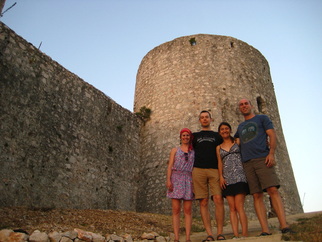
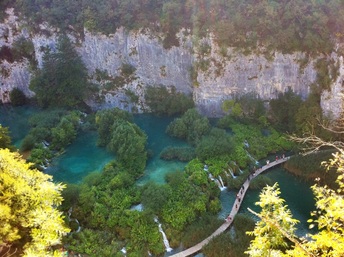
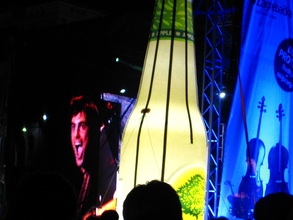
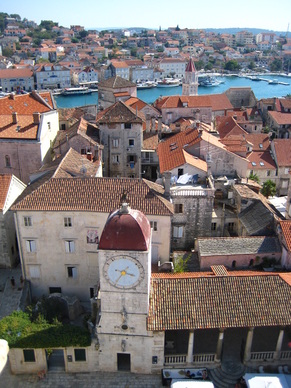
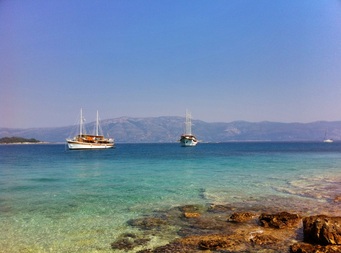
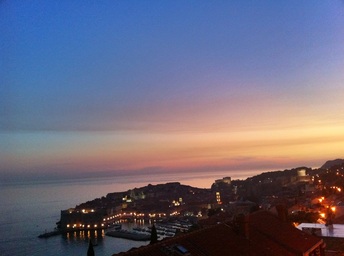
Croatia is a country still trying to find itself after 46 years of communist rule followed by a brutal war where Croatia fought against Serbia and the former Yugoslavia army for its very existence. It was only in 1995 that it established its independence and found a semblance of stability. Now, 17 years later, Croatia is on the cusp of EU membership and its economy is held afloat by the massive amount of tourists that visits its nearly 6,000 kilometers of beautiful coastline.  Amy, Tom, Neda, and Jeff at the Crikvenica fortress Tom introduced us to some classic Croatian dishes like black cuttlefish risotto and the home made “surlice” noodle served with white wine, cream, and fresh seafood. Croatia was under Venetian rule for nearly 700 years and so Italian influences intertwine with the typical Slavic kitchen in delightful ways. The fresh seafood and pasta were highlights of our time there. While in Crikvenica, we also got to meet Tom’s parents and enjoy some delicious meals with them. Tom & Amy took us on a day trip to the island of Krk where we swam in deliriously clear turquoise water and sampled white wines made from the delicious local Zhlatina grape. Perhaps the most fun came as we were riding along the road and spotting bountiful fig trees, heavy with unpicked fruit. Tom would pull off to the side of the road and we would all run out to collect as much booty as possible. A few extra plastic bags that Neda brought were soon stuffed with ripe figs. We ate so many that our tongues went slightly numb, but it didn’t stop us from feasting on surlice while enjoying beautiful views of the Croatian mainlaind across the sea. Thanks for your hospitality, Golubs! See all of our pics of our time with Tom and Amy here: http://flic.kr/s/aHsjBC1StJ.  Plitvice lakes from above We parted with Tom & Amy for the only part of our trip that took us inland – Plitvice National Park. Plitvice is formed from several lakes connected by underground rivers and limestone karsts. The movement of the calcium rich travertine around the lakes has formed numerous waterfalls and cataracts, which when combined with the gorgeous hue of the lakes water, makes for a magical experience. The entire lake complex is lined with wooden walkways that traverse the swampy parts of the lake and allow you to get some amazing views of the falls. With only a few hours to see the park before trying to catch an onward bus, however, Neda and I found ourselves dodging past tourist after tourist on the walkways as we took in as much of the park as we could. See all the pics of Plitvice here: http://flic.kr/s/aHsjBD1Fhs. Bus service from Plitvice is pretty limited and after missing the bus to Zadar, we had only one other possible bus we could catch to the rarely visited city of Knin, known mostly for its cliffside fortress and for being the stronghold of the Serbian push to takeover Croatia. We tried hitchhiking to get to a better destination down south, but were met only by zooming cars for over a half hour. Finally, the bus to Knin pulled up, and lacking any other options, we got on! It was one of our more adventurous days in Croatia because as we talked to some locals on the bus to Knin we found out that accommodation was pretty scarce in town. Eventually, a Croatian woman from the bus talked to a local at the station who was kind enough to drive us to the only hotel in town – a shabby little place that still charged us $50 for the night because it was “high season”. That was just the beginning of our realization that Croatia was going to be one of the most expensive places we’ve visited over the whole of our travels. The exhausting day at Plitvice was going to be followed by another national park full of waterfalls, but at the last moment at the Knin bus stop we changed our minds and ran over to a train headed for Split. Without a car, the logistics of seeing Krka National Park was nightmarish and we’d just had enough. It turned out to be the right decision.  Crazy celoist rocking out We arrived in Split and a local woman waiting at the station convinced us to check out an apartment she had just outside the center. The place was wonderful at the right price so we spent 3 nights in Split, enjoying all the city had to offer. On the first night, two famous Croatia celloist played pop-rock songs on the waterfront – a spectacle that couldn’t help but make Neda and me laugh at some points. Check out their rendition of smells like teen spirit: http://youtu.be/XqkbN0I_Iac.  View of Trogir from bellfry Split was the site of the retirement palace of the Roman Emperor Diocletian at the turn of the 4th century. Diocletian http://en.wikipedia.org/wiki/Diocletian was a fascinating emperor, coming from a Croatian slave family before rising up to the rank of Emperor through military and political cunning. He bears the distinction of being the first emperor to think up the idea of retirement (I like this guy already!) and one of the few to die of natural causes. His retirement palace was a massive structure that would alter the course of Split’s history. About 300 years after his death, as the Roman empire fell, the citizens of Diocletian’s native Salona fled to the now ruined palace as a place of refuge. There they set up shops and homes in the halls and towers of the palace – slowly modifying it into what would become the center of the city of Split. To this day, the palace still occupies the center of the city, and Neda & I had a wonderful time exploring its ruins. We climbed the bell tower (built later next to Diocletian’s mausoleum) for sweeping views over the palace and city and also climbed a hill outside the city, where we would have enjoyed a beer as the sun set on Split if we’d have remembered to bring some cash! We also took a day trip to Trogir, a well preserved medieval town just north of Split. See all of our pics of Split and Trogir here: http://flic.kr/s/aHsjBDgBfQ. From Split we took a ferry to ancient town of Stari Grad on the island of Hvar. Stari Grad is the oldest recorded town in Croatia, though for us it was all about sipping white wine at cafés, enjoying the town’s splendid rock beaches, and catching a showing of the local film “Lavender Man”. Full of inside jokes about the island and horribly drab dialogue between the superhero Lavendar Man and an investigating reporter, I fell asleep on the film pretty rapidly, despite my attempts at revival with a Jack and Coke! Hvar Town on the other side of the island features some interesting architecture, as the Spanjola Fortress rises behind the city’s cathedrals and palaces. After a day stop here, we were off to Korcula, our next island.  The beautiful Lumbarda Beach!! Korcula Town is a beautifully symmetric bit of land that juts out into sea in the shape of a leaf. The town is laid out like the veins of the leaf, with a main street running down the middle and side streets branching off from there. This keeps much of the old town in shade during the hot summer days. Korcula is also the first town on record to outlaw slavery in 1214. The town is very very small and so suffers a bit from tourist overload, but a short bus ride to Lumbarda brought beautiful beaches, delicious local white wines (yet again), and one of our favorite meals – the Lumbardian platter in a restaurant based in an abandoned boathouse on the beach. Island food in Croatia revolves several dishes, which we often enjoyed. There is the Octopus Salad, which when prepared with oil, citrus juices, red onions, and capers becomes a cacophony of flavors on the palate. We also savored the salted and marinated anchovies, the sheep cheese from the island of Pag, and the delicious prosciutto (though the prosciutto didn’t quite compare to our trip in Italy!). See all the pics of Hvar and Korcula here: http://flic.kr/s/aHsjBHbhCs.  Mesmerizing view of Dubrovnik from our balcony Finally, our trip in Croatia ended all the way on the southern tip with the stunning city of Dubrovnik. Dubrovnik holds special significance for Croatians because during medieval times the city and its small republic (called Ragusa) managed to stay mostly independent in its governance. It was one of the most important port cities in all of Europe and its connections and trading posts in what is today Eastern Europe allowed it to turn fat profits as it resold goods to its Western neighbors. The result of this wealth, as well as an earthquake in 1667 that leveled most of the city, is an orderly Baroque city with towering city walls, smooth marbled streets, and a variety of lovely palaces, cathedrals, and fortresses. Neda and I got a lot of exercise while staying in Dubrovnik, staying in a hotel up the hill outside of the old city. Our location was rewarded with stunning views of the city and a 900 step walk down to the beach! While in Dubronik, we stayed healthy by eating at the wonderful salad bar at Nishta and stayed naughty with cigars and wine outside of Orlando’s fountain while listening to jazz. Dubrovnik is best avoided during the peak of the day, when visiting cruise ships turn it into a sardine can, but in the early morning and in the evenings the town settles back into lucidity and can be enjoyed in all of its stunning beauty. Our intended trip to the island of Mljet was also deep sixed when we arrived at the ferry an hour early, only to miss the last tickets by about 10 people. So, a day trip to the beautiful Tristeno gardens in lieu of Mljet soothed us with its beautiful Neptune fountain. Finally, we flew up to Zagreb, where we had a few hours to explore the city before heading off to Slovenia. See all of our pics of Dubrovnik, Tristeno, and Zagreb here: http://flic.kr/s/aHsjBQjkiq. All in all, Croatia was a beautiful country and a great place to meet up with our friends. But as it relied on tourism as its number one trade, authentic experiences were a bit more difficult to find along the coast, causing Neda and me to feel like we were really on typical recreational vacation more so than in most other places. This is a good thing in some ways, but not so good for our wallets, which were burning up as we passed through the tourism tunnel that is the Croatian coast. We were glad to leave the beach and the beauty behind and head for less crowded territory in the tiny country of Slovenia…
0 Comments
Leave a Reply. |